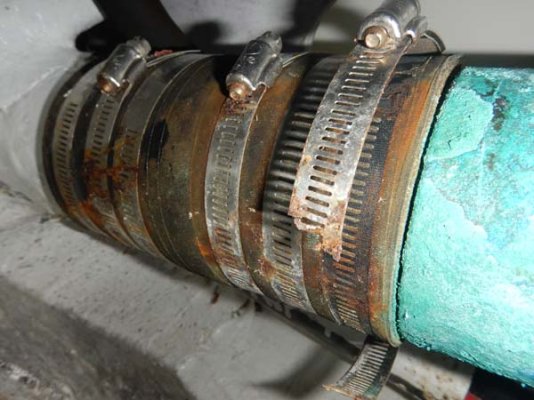This is an issue I encounter on an all too frequent basis; the hose clamps for stuffing boxes look pristine on the upper hemisphere, in fact they look good from the 7:00 o'clock position all the way around to the 5:00 o'clock position. It's at the 6:00 o'clock position where the problem begins. This is the area that's so often wet from leaking packing or seals, and it's where clamp bands suffer the most. In the attached photo (looking upward at the bottom of the stuffing box hose), taken aboard a vessel I inspected recently, the band has actually parted, I see this a lot. The top of the band remains in place by virtue of the fact that it's stuck to the hose after being there for years.
Bottom line, inspect your stuffing box hose clamps regularly, including and especially the bottom section, you may need a mirror or point and shoot camera to do this. As an aside, the 'folded spot weld' used on most T bolt style clamps is particularly susceptible to crevice corrosion. Be sure the spot weld area is located on the upper hemisphere of the hose. I recommend saturating the fold with CRC HD Corrosion Inhibitor, or use the style that relies on an interlock rather than spot weld.
This two part article goes into detail about clamp selection and installation, including the T-bolt issue...
https://stevedmarineconsulting.com/hose-clamps-part-i-design-and-selection/
https://stevedmarineconsulting.com/hose-clamps-part-ii-installation-and-use/
(In Kaohsiung, Taiwan)
Bottom line, inspect your stuffing box hose clamps regularly, including and especially the bottom section, you may need a mirror or point and shoot camera to do this. As an aside, the 'folded spot weld' used on most T bolt style clamps is particularly susceptible to crevice corrosion. Be sure the spot weld area is located on the upper hemisphere of the hose. I recommend saturating the fold with CRC HD Corrosion Inhibitor, or use the style that relies on an interlock rather than spot weld.
This two part article goes into detail about clamp selection and installation, including the T-bolt issue...
https://stevedmarineconsulting.com/hose-clamps-part-i-design-and-selection/
https://stevedmarineconsulting.com/hose-clamps-part-ii-installation-and-use/
(In Kaohsiung, Taiwan)

